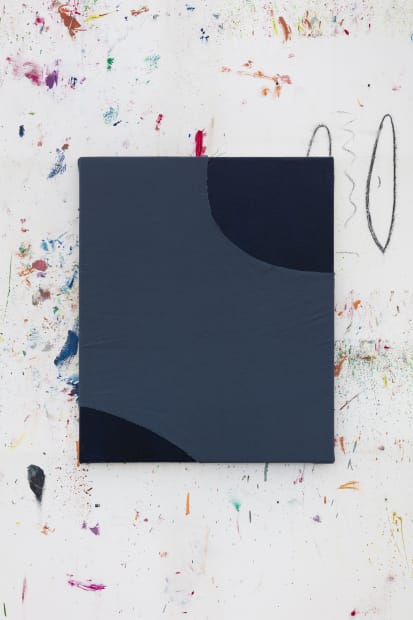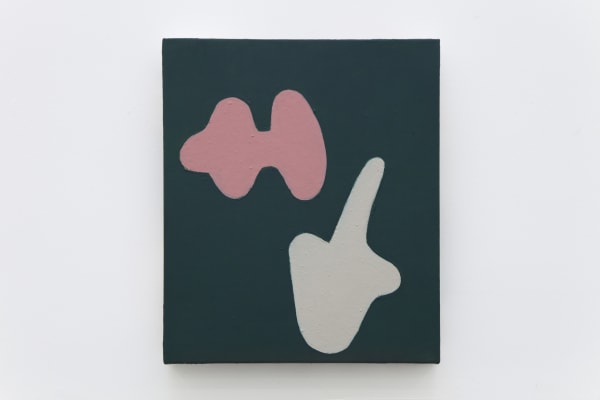-
Rodrigo Bivar: Gema
5 Agoust - 1 September 2020
-

-
-
Yes, this is what my senses learned on their own:
– Things do not have a meaning: they have an existence.
Things are the only hidden meaning of things. -
Alberto Caeiro
-

-
Behind an apparent simplicity, the paintings seem to have an inner time that is untouched by haste. They cause the sensation that the artist finds out forms within forms, as if every gesture was an ever-refined intimacy. Bivar addresses materials - not in a pruning operation like that of a sculptor on stone or marble -, but using free, moldable and changeable manipulation of whatever is plastic. If only we could touch the forms seen on the paintings with our own hands, they would have a soft touch.
*
A painting is a result. It undergoes as many tests as it takes to get to its final form. So we cannot resist to wonder that there are other colors and drawings hidden underneath what is seen on the last layer. According to Bivar, this is 'useless archeology'.
*
Some works do not fit into the paint and canvas “formula”. Maybe they exist to deny formulas and stress the possibility and freedom of what belongs to the visual field. The use of fabric in Hábitos Noturnos (Night Habits), for instance, creates forms through cutouts on the fabric. It is like the painting is wearing a mask that reveals the faceinstead of hiding it. An anti-archeology.
*
Flaubert said that the purpose of art was to make one see so that it could make one dream (faire rêver). Bivar's paintings seem to teach us how to see without the vice of explanations, comparisons, interpretations. Images remain – as if one could not 'unsee' them after having seen them. And they continue their drawing in space: they not only make one dream, but they could have come out of the artist's own dreams – which would create an endless circuit and transformation.Laura Liuzzi
-

-
-
-
Rodrigo Bivar began his career in the early 2000s and, from this moment, his pictorial production was closer to figuration, however with a desired strangeness as in the angle at which the figures meet and in the lack of hierarchies between the elements. Along his career, when he distanced himself from figuration, Bivar restructured the painting through the combination of forms and masses of color. He often paints structures that orbit the pictorial space, proposing varied associations.
As curator Tiago Mesquita stated in 2019, Bivar “treats the pathetic mismatch between what is expected and what happens with humor. The painting for him seems to happen when the loose ends get tangled and show that the exception has become the rule”.
Rodrigo Bivar has a degree in Visual Arts at Fundação Armando Álvares Penteado (2005 - São Paulo, Brazil). In 2020, Bivar was awarded the major prize from the Pollock-Krasner Foundation Grant 2020-2021, and in 2008 he was awarded the Acquisition Prize from Centro Cultural de São Paulo (São Paulo, Brazil), when he held his first individual exhibition at this institution. Since then, he did several solo exhibitions, highlighting: 2020 - Gema (Galeria Athena - Rio de Janeiro, Brazil); 2018 - É Umas (Galeria Millan - São Paulo, Brazil); 2017 - Rodrigo Bivar (Instituto Figueiredo Ferraz - Sao Paulo, Brazil); 2016 - Nada pensa nada (Galeria Athena Contemporânea - Rio de Janeiro, Brazil); 2010 - Turista Azul (Paço das Artes - São Paulo, Brazil); among others.
Bivar has been part of group exhibitions among which: 2019 - Construções e Geometrias (Museu Brasileiro de Escultura e Ecologia - São Paulo, Brazil); 2018 - Com o ar pesado demais pra respirar (Galeria Athena - Rio de Janeiro, Brazil); 2017 - Os Desígnios da Arte Contemporânea no Brasil (Museu de Arte Contemporânea da Universidade de São Paulo – São Paulo, Brazil); 2016 - Os muitos e o um: Arte contemporânea brasileira (Instituto Tomie Ohtake - São Paulo, Brazil); 2013 - Sesc VideoBrasil: 18º Festival Internacional de Arte Contemporânea (SESC Pompéia – São Paulo, Brazil); 2011 - Itinerários, Itinerâncias, Panorama da Arte Brasileira (Museu de Arte Moderna de São Paulo – São Paulo, Brazil); among others.
Rodrigo Bivar signs as a curator in three exhibitions, and has works in important collections such as: Museu de Arte do Rio (Rio de Janeiro, Brazil), Centro Cultural de São Paulo (São Paulo, Brazil), Museu de Arte Contemporânea da Universidade de São Paulo (São Paulo, Brazil) and Instituto Figueiredo Ferraz (Ribeirão Preto, Brazil).














